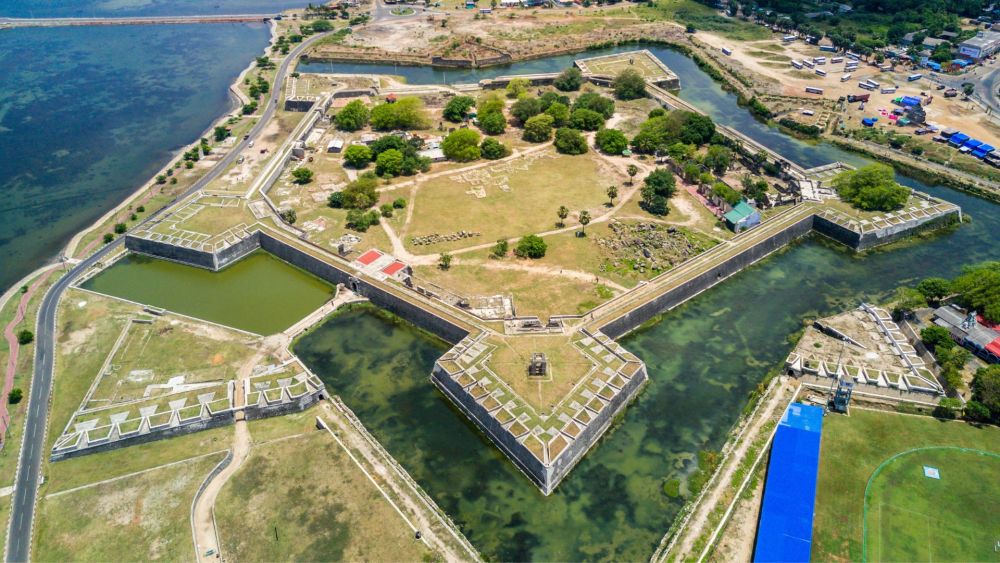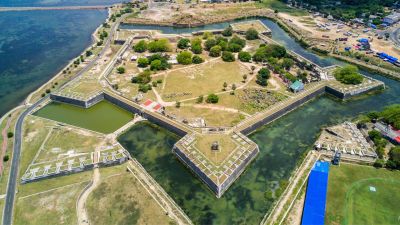

Take a journey back in time as you stroll through the historic Jaffna Fort, which stands as a testament to the colonial history of Sri Lanka. Constructed by the Portuguese in 1618, later expanded by the Dutch, and finally falling under the British rule, this fort has been a witness to centuries of colonial strife and local resistance. Wander the ramparts and explore the ruins, where you can still see the remnants of the old administrative buildings, the Queen's House, the Governor's residence, and an old church. Interpretive boards scattered around the site offer historical insights into the fort's significance during various periods. The panoramic view of the Jaffna Peninsula from the fort walls is an added bonus, providing a beautiful vista of the surrounding landscape and the Indian Ocean.
Experience the magical hour at Jaffna Fort when the sky turns into a canvas of warm hues. Watching the sunset from the fort's ramparts is a relaxing activity that draws both tourists and locals alike. As the twilight embraces the fort, the surrounding moat and the structures within are bathed in golden light, creating a serene and picturesque atmosphere. It's an ideal moment for photographers and romantics to capture the beauty of Jaffna. The fort becomes less crowded during this time, allowing for a more intimate encounter with its history and ambiance. Remember to bring your camera for this is a visual spectacle you would want to cherish and share.
Photography enthusiasts will find Jaffna Fort a perfect subject for a thematic photo expedition. The fort's architecture, with its time-worn stones and historical backdrop, makes for dramatic compositions. Capture the ancient walls, the traditional Dutch architecture, and the bastions that each tell a story. The varying textures and layers of decay provide a rich tapestry of visual interest and a challenge for any photographer aiming to convey the essence of this storied place. Whether you're a professional photographer or a hobbyist, the fort's interplay of light, shadow, and history can yield stunning images that echo the fort's past.
To fully understand and appreciate the rich history of Jaffna Fort, consider hiring a local guide. A knowledgeable guide can provide you with in-depth information about the fort's past, including tales of battles and sieges. They also bring to life the everyday stories of the people who lived and worked within the fort's walls. Interacting with a local guide gives you an opportunity to ask questions, delve deeper into the local culture, and hear firsthand accounts of the fort's significance in the regional context. Furthermore, this activity supports the local economy and fosters cultural exchange.
Pack a lunch and enjoy a leisurely picnic within the spacious grounds of the Jaffna Fort. The large green spaces provide a peaceful setting to relax with family and friends. You can sit under the shade of a tree and take in the scenic views while enjoying local or homemade food. Picnicking here allows for a casual way to enjoy the fort's ambiance without the structure of a guided tour. Remember to carry your trash with you to keep the historic site clean and respect the local environment and heritage.
Make time to visit the Jaffna Archaeological Museum, situated near the entrance of the Jaffna Fort. Though small, the museum hosts a collection of artifacts that showcase the region's history and heritage, including items from the Tamil and Buddhist cultures that have flourished in the area. The museum allows visitors to better contextualize the historical importance of the fort and understand the various civilizations that influenced the culture of Northern Sri Lanka. From coins to sculptures and colonial relics, the exhibits offer insight into the past of Jaffna and its surroundings.
The moat surrounding Jaffna Fort, once a defensive feature, is now a tranquil body of water that offers a serene spot for relaxation and contemplation. Visitors can enjoy the calm and watch local wildlife that has made the moat its habitat. It is not uncommon to see birds, fish, and even monitor lizards in the vicinity. Sitting by the moat is a great way to unwind after exploring the fort and to reflect upon the historical significance of the fortifications that once protected the city from invaders.
Although not inside the fort, visitors can extend their Jaffna Fort experience by shopping for local handicrafts at nearby stalls and shops. Jaffna is known for its vibrant handicrafts made by local artisans, including beautiful Palmyra palm products, intricate lacework, and traditional Tamil pottery. These items make for unique souvenirs and gifts. Engaging with local craftsmen also offers insight into the cultural traditions of the region and supports local industries. It's a wonderful way to take a piece of Jaffna's cultural heritage home with you.
After exploring the historic Jaffna Fort, take your taste buds on an adventure with a food tour in the surrounding areas. Jaffna's cuisine is distinct from the rest of Sri Lanka, featuring bold flavors and unique dishes such as Jaffna crab curry, dosai, and the sweet treat known as kokis. Food tours typically take you to local eateries, street food stalls, and markets where you can savor these delicacies. Such tours not only offer a taste of the local fare but also provide a cultural context to the culinary traditions of the Northern Province.
For the more adventurous, a cycling tour starting from Jaffna Fort and extending around the Jaffna Peninsula offers a unique perspective of the area. These guided tours allow you to cover more ground than walking, taking in various landmarks, local neighborhoods, and scenic views along the coast. Cycling is a great way to engage with the local environment, and the flat terrain of the region makes it suitable for all fitness levels. Rental bicycles are available, and tours can often be tailored to suit your interests and time constraints.
